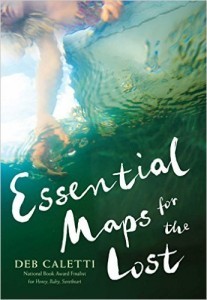Book Review: Essential Maps For The Lost
“A husband might ditch the joint, but a daughter never can,” eighteen-year-old Mads reflects. Having graduated high school early, she’s now living with her aunt and uncle taking an intensive community college course so she can get her realtor’s licence, and join her mother’s practice. Never mind that it’s not what she wants – that her dream is to study English at university – this is the path that’s been set out for her. And she’s drowning in it.
This sophisticated YA novel by the prolific Seattle-based Deb Caletti, who’s produced a book a year for over a decade, is set near the water, and drowning both metaphorically and literally is at its heart. On a morning swim, Mads encounters a dead body and pulls it to shore, an experience that pushes her further into the depression that she’s struggling with. She becomes obsessed with the drowned woman, who threw herself off a nearby bridge, and goes to her old home – where she meets her nineteen-year-old son, Billy, for the first but not the last time.
Billy is a decent guy, but haunted by his mother’s death and the years of upset before that; now he lives with his unsympathetic grandmother and steals badly-treated dogs from their owners, then deposits them at the shelter he works with, claiming that they’re ‘lost’. Without hammering the point home, we can see that both he and Mads are lost in their own way, living in a world where terrible things happen and there are no easy answers. “A why without an answer,” Mads thinks, “is the worst kind of lost thing – a lost thing you never had to begin with.”
And then there are maps – the maps that can help lost travellers along the way. Billy’s mother’s favourite book was From The Mixed-Up Files of Mrs Basil E Frankweiler by E L Konigsburg, and he still carries around the map from within the novel – a floor plan of the Metropolitan Museum of Modern Art, where the two characters in the book run away to. Mixed-Up Files becomes a touchstone for Mads and Billy, and this novel – deviating from Caletti’s usual tendency to write in the first person – uses the same ‘God voice’ that Konigsburg adopts, allowing us to see two rounded, imperfect characters trying to figure out how to deal with the different kinds of grief that hit us in life – and how to handle the love that sometimes feels too scary or fragile to trust.
Caletti’s prose is fresh and quirky without ever getting irritating; optimistic without being saccharine. As in her other YA novels, the teenage protagonists being the central focus doesn’t mean that the others – the adults, the children, and the dogs – in their world aren’t carefully characterised as well. Fans of Gayle Forman’s I Was Here or Jennifer Niven’s All The Bright Places should pick this one up.




